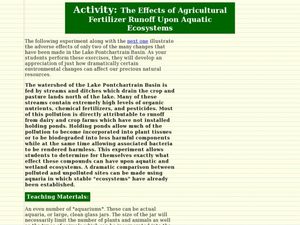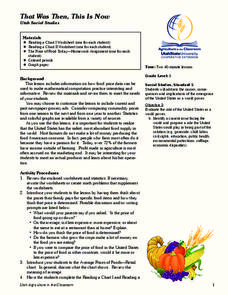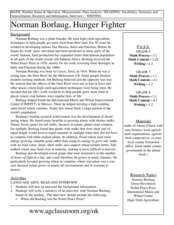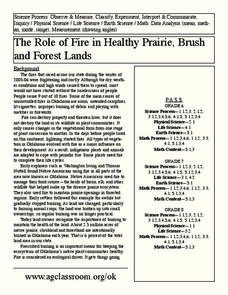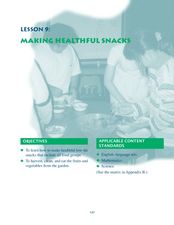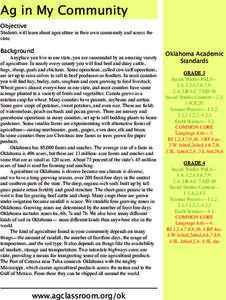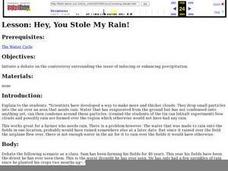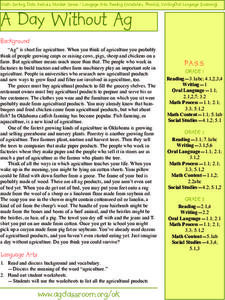Curated OER
Agriculture in Your Life
Students explore the origins of food and other everyday products around the United States. In this agricultural lesson, students learn basic vocabulary and practice matching common items with their agricultural source. They categorize...
Curated OER
The Effects of Agricultural Fertilizer Runoff Upon Aquatic Ecosystems
Students measure the toxic levels of runoff and discuss the effects it would have on the aquatic system. In this runoff lesson plan, students answer questions to how runoff would affect the animals in an aquatic system.
Curated OER
Public lands: Preserve or develop?
Students compare and contrast the characteristics of various public lands in Canada, including national forests, wilderness areas, national and provincial parks, wildlife sanctuaries, recreation areas and national historic sites. They...
Curated OER
George Washington Carver
Second graders participate in an investigation of George Washington Carver and his life. They conduct research using the provided text. Specifically, 2nd graders use the large print and pictures to strengthen reading comprehension. They...
Curated OER
HAPPY SOIL, SAD SOIL
Students will be able to identify the characteristics of healthy soil and unhealthy soil.Take the class outside to an area of thick grass near trees, if available. Compare the
clothes people wear to the thin cover. Discuss the reasons...
Curated OER
Space Age Technology Comes to Earth
Students explore jobs related to agriculture. In this technology/agriculture lesson plan, students recognize the importance of natural resources and agriculture on the use of Range Rambler software. Students complete an experiment...
Curated OER
That was Then, This is Now
Students compare and contrast data charts and statistics for food prices of now and in the past. In this food prices lesson plan, students answer short answer questions and calculate computations.
Curated OER
Granary Door Dogon, Mali
Young scholars explore a creation myth. In this visual arts lesson, students discuss the Dogon creation myth and the design and make refrigerator magnets in the style of Dogan granary doors. The design of the magnets should include...
Curated OER
Norman Borlaug, Hunger Fighter
Students study Norman Borlaug. In this reading and math lesson, students research Norman Borlaug's work and write a narrative interview with Borlaug. Students complete a variety of activities using wheat stalks.
Curated OER
The Role of Fire in Healthy Prairie, Brush and Forest Lands
Students create a Venn diagram to compare and contrast wildfires and prescribed fires. In this earth science lesson, students conduct a series of experiment to explore fire characteristics. They describe favorable conditions to start a...
Curated OER
Making Healthful Snacks
Students examine how to make healthy snacks that include all the food groups and how to harvest, clean and eat fruits and veggies from the garden. In this healthy snack instructional activity students complete several activities...
Curated OER
Experimenting with Peanuts
Students investigate peanuts. For this science lesson, students explore the properties of the peanut and shell. Students burn a peanut to observe the peanut oil. Students taste test different types of peanut butter.
Curated OER
Agriculture
Students examine the types of agriculture in their own state and in their local community. They examine how food makes it to their local grocery store. They compare data from different states.
Curated OER
Erosion Exploration
Ninth graders investigate the factors that increase soil erosion. They identify how the environment is affected by erosion. In small groups, 9th graders research erosion problems in various locations. Groups brainstorm ideas to help...
Curated OER
Soil, Forest, and Land Exploitation
Students debate over the cutting of rainforests in order to put people to work. They then brainstorm ways it may be possible to provide jobs for people and to preserve the rainforest.
Curated OER
What does AG have to do with me?
Students practice alphabetizing while categorizing sources of basic agricultural products. They discuss agricultrual products, discover where they are grown and draw a simple agricultural scene on poster board.
Curated OER
Mud in the Water
Students build a soil erosion model to study the importance of soil conservation. They investigate how land forms from both constructive and destructive forces.
Curated OER
A DAY WITHOUT AG
Students consider and discuss the meaning of the word "agriculture" and how agriculture affects their lives every day. Students identify the various ways that agriculture touches their personal lives. Students use worksheets to list all...
Curated OER
Hey, You Stole My Rain!
Students review various scenarios in regards to the water cycle to determine what the best solution is to the problem. Students write their opinions on the controversies.
Curated OER
A Day Without Ag
Learners investigate the concept of agriculture. They focus upon the presence of agriculture and the personal implications of it. Students generate lists related to the concept to encourage group discussions. The products of agriculture...
Curated OER
Influence of Geography on the Migration of Virginians
Sixth graders study how geography influenced the westward migration of Virginians. They review the settlement patterns of early Virginians before discussing reasons why people move away from an area. Looking at maps, they determine how...
Curated OER
Mound Cities
Learners learn about Mound Cities and how they both started and stopped. In this Mound lesson students explore how Mound Cities did not succeed and why. Learners dig deeper then the lesson as they discuss defeat and relate it to their...
Curated OER
Arkansas Regions As They Relate To Slave Population
Fifth graders evaluate how the characteristics of Arkansas' regions affect the slave population.
Curated OER
Trees for Tomorrow
Students examine how to plan for prudent use of trees so that we never run out of this natural resource. They determine what the oldest wooden object in their home is and draw picture of it. They observe a cross section of a tree and...

